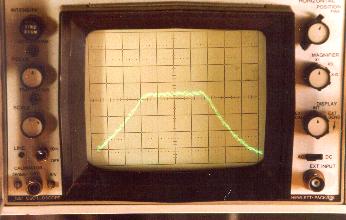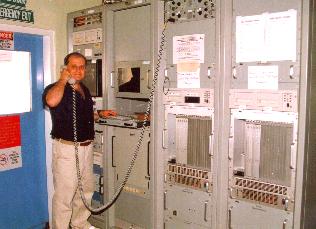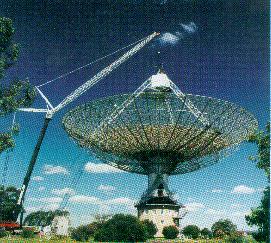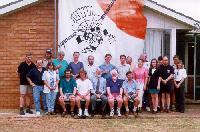Soon after the launch of the Galileo spacecraft in October 1989, the main communications antenna of the spacecraft failed to unfurl properly. Unlike on previous spacecraft, the Galileo antenna was not a rigid structure. Instead, it was designed to be folded up prior to launch, and unfurled, like an umbrella, once the spacecraft was safely enroute to Jupiter. Unfortunately, the straps holding the folded antenna in place, failed to respond to commands. Despite several ingenious methods to open the antenna, it remained stuck in a partially unfurled state. This rendered the antenna useless.
Fortunately, there existed a small antenna on the spacecraft whose operation was capable of being modified, to recover the precious scientific data. This antenna is a small rod-type aerial that transmits at very low power in all directions. This means that any signal reaching the Earth is extremely weak, weaker in fact than the static in the radio receivers on Earth.

The passband from the Parkes Galileo receiver. The weak signal is lost in the static on the plateau region of the band. |
In order to extract the signal from this background static, several antennas had to be linked together, or "arrayed", and their signals combined. This boost in the received signal strength allowed the weak signal from the Galileo spacecraft to emerge above the background static in a useable form. The weakness of the signal also meant that the rate of the data flow had to be kept very low. To maximise the amount of data transmitted to Earth, new and very sophisticated data compression techniques were, also, designed and implemented. With these changes, the data rate was increased to a maximum of 160 bits per second (bps), which is considerably down on the originally planned rate of 134,000 bps.
This effort salvaged the mission from near disaster, and has meant that 70% of the original science goals of the mission have been met.
ARRAYING
The secret of the Galileo mission's success has been the intercontinental linking of the various tracking antennas, referred to as "arraying". This arraying network has cost NASA US$30.5 million to establish, and will be used, in one way or another, on all future planetary missions.
Essentially, the arraying involved linking the Parkes 64 metre dish with the 70 metre antennas of NASA's Deep Space Tracking Network at Goldstone in California, Tidbinbilla near Canberra and Madrid in Spain. In addition, some of the smaller34 metre antennas at these stations were also included.

The Full Spectrum Resolvers (FSR) were used to extract the signal from the static, and then pass the data to Tidbinbilla for combining. |
As the rotation of the Earth successively brought the various stations into view of Galileo, the tracking antennas at these sites would lock on to the spacecraft orbiting Jupiter, and track it until it set at their site. The positions of the stations around the globe meant that the tracking periods at each site would overlap with one another for a short time. It was during these overlap periods that the data rate was programmed to increase. In fact whenever Parkes came on line, the data rate would peak at 160 bps. It was then that the Parkes 64 m dish was arrayed with the 70 m dish at Goldstone as well as with the 70 m dish and two of the 34 m dishes at Tidbinbilla. During this overlap period of two hours, a total of five antennas would be pointing in unison at Galileo.
With the handing-off of one station to another, the data rate would be constantly adjusted to accommodate the varying number of antennas tracking the spacecraft.
At times, the spacecraft was as much as 48 light minutes from the Earth, that is, it took the radio signal 48 minutes to travel from the vicinity of Jupiter to the Earth. The spacecraft was pre-programmed to alter the rate at which it transmitted its data to Earth by the correct amount, and at just the right moment, for it to be received on Earth when the various stations of the tracking network came into view. For this reason, it was imperative that each of the antennas was locked on and tracking the spacecraft at it's scheduled time. Any loss of tracking time, by any of the dishes in the array, meant that the data was lost. Since the gathered data was always first recorded on the spacecraft's onboard video tape, any lost data that was considered sufficiently important by JPL scientists, was re-scheduled for playback at a later time. You may have seen some Galileo images that had black stripes cutting across them. This indicates that during the transmission, one or several of the antennas was off source, and the data loss was not deemed serious enough to warrant re-transmission of the missing frames.
PARKES' INVOLVEMENT
Soon after the antenna problem was diagnosed, the observatory was contacted by NASA/JPL to assist in the data recovery. Being conscious of the valuable and important nature of the mission, the CSIRO's Australia Telescope National Facility (ATNF) agreed to become involved in the effort.

The new aerial cabin being installed. The old cabin is in the foreground resembling a lunar module. |
In order to commit itself to performing the tracks over such a long period, and at the same time continue to perform general astronomy observations, the observatory had to first modify the telescope. This modification was necessary in order to accommodate the new "Galileo" receiver, and to allow for a greater flexibility in receiver allocation. To this end, NASA agreed to finance the construction of a new aerial cabin, which is the room at the focus of the telescope that houses the observing receivers. This allowed for the rapid placement, at the focus of the telescope, of any one of the four selectable receiver packages in the cabin. This compared with just one for the old aerial cabin. The increased frequency agility, has meant that general astronomy observing has now become more efficient and flexible than before, thus increasing the utility and capability of the Parkes radio telescope.
In addition to the new aerial cabin, a new low-noise S-band receiver was also built by ATNF to receive the weak signals. This new receiver is already being used by radio astronomers for many other diverse observations.
The construction of the new aerial cabin was completed in early 1996, and in March of that year, the first of the trial tracks was conducted. The contracted tracking period commenced on 28 October 1996, and continued for about nine hours every day until 6 November 1997.
THE TRACKING DUTIES
The daily tracks were performed by three principle Galileo operators - Dr. Ian Stewart, Mr. Russell Pace and Mr. John Sarkissian. At certain times, other observatory staff also assisted in performing some of the tracking duties.
With the passage of the seasons at Parkes, the starting times of the daily 9 hour tracks slowly progressed through the day. This meant that the tracks gradually changed over the year, from occurring wholly within daylight hours, to being wholly within the night. As you can imagine, the night tracks often saw us alone at the telescope quietly going about our tasks. At these times, the early morning drive from the town to the telescope, would often see the operators dodging the kangaroos and rabbits along the way, and the beckoning sight of Jupiter rising in the East was inspiring.

Some of the Galileo operators, at the end of the last Parkes Galileo track - 6 November 1997. |
During the tracks, the operators would constantly monitor the status of the telescope and the receiver, ever ready to take immediate control if anything untoward should happen. It was seldom that track time was lost, but when it was, it was almost always due to the wind. For structural and safety reasons, the telescope is designed to stow whenever the winds reach a critical speed. These wind stow situations were a source of frustration, which JPL was able to work around with minimal impact on the data reception.
The most serious problem to occur, happened in early October 1997, when a critical component of the observatory's hydrogen maser clock failed. This clock is extremely accurate and was used to time the arrival of the Galileo signals so they can be correctly combined with the signals from the other antennas. The observatory technical staff was able to quickly get a replacement part in from JPL and have it installed. Fortunately for us, we were aided by the fact that the Mars Pathfinder probe experienced communications problems at this time. The Galileo tracking duties were suspended for a short time, so that communications with the Mars lander could be re-established using the 70 m dish at Tidbinbilla. This break in the tracking, gave us sufficient time to repair the clock, and no tracking time was lost as a result. It's interesting to note, that proper contact was never re-established with the Mars Pathfinder probe, and operations with it were subsequently discontinued.
Another, quite amusing problem, would often come from an unexpected source. The telescope tracking system uses a directed laser beam to lock the telescope on a desired position in the sky. On balmy summer evenings, moths from the surrounding farm fields would often infiltrate the room housing the laser and fly across the beam, thus, causing the telescope to temporarily lose lock on the spacecraft. This was a minor irritant that never caused major concern. Many solutions were devised, but the most effective seemed to be a rolled up newspaper. It was always amusing to contemplate how such little moths could disrupt the very high-tech, and sophisticated, global tracking effort.
On all previous planetary missions, the data rate from the spacecraft was sufficiently great to allow for the real-time processing of the data and its display within minutes of reception. With Galileo however, the low bit rate meant that it often took weeks, for the information to be fully received and processed. Consequently, we saw the magnificent images of the Jovian system when everyone else did - on the internet. We did not have a privileged position in that respect.
Contrary to the experience on other missions, the encounter periods, when the spacecraft would make close passes of the Jovian moons, were never occasions of frantic and critical activity at the telescope. Owing to the low bit rate, the information gathered during these fly-bys was recorded on the onboard video tapes and played back at leisure in the weeks following the encounter. The unique and important bits of information were downlinked first, followed by the less critical information. Sometimes, if all the data was not downlinked before the next encounter, it was written over. Such was the way of Galileo.
The Parkes Galileo team developed an excellent working relationship with the various tracking teams at Tidbinbilla and JPL. We were often able to solve problems before they arose and posed a threat to the data acquisition.
CONCLUSION

Celebrating the end of the Galileo tracks. Parkes Observatory staff - 14 November 1997. |
On 6 November 1997, the Galileo spacecraft passed the smallest of Jupiter's big moons, Europa. With this encounter, the primary 11 orbit tour of the Jovian system was successfully completed. This also, represented the completion of the Parkes Galileo tracking duties. We at the observatory, have taken great pride in the knowledge that no tracking time was lost due to equipment failure or operator error. We managed to track the spacecraft for over 97.5 % of the assigned tracking time, which greatly exceeded all expectations.
The Galileo spacecraft will continue to perform for a further two years in the extended "Galileo Europa Mission" (GEM). It will gather new and vital information about the Jovian system, in particular of the moon Europa. Eight close fly-bys of the moon are scheduled, followed by four fly-bys of the second largest Jovian moon, Callisto. To finish the extended mission, a passage through the Jovian radiation belts is planned, with a further one or two encounters with Io.
Though Parkes will not be involved in this extended mission, we all wish the NASA/JPL Galileo team continued success and good fortune. We all look forward to seeing the sweeping images of the awesome Jovian vistas.
It has been a privilege for the observatory to share in the acquisition of so much new knowledge of the Jovian system. With its participation in this mission, the observatory has continued its proud record of contributing to the success of some of the most significant and historic space missions to date.
John M. Sarkissian.
Co-ordinator of Galileo Tracking Operations
Parkes Radio Observatory,
Australia Telescope National Facility.
November, 1997.




